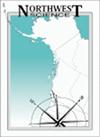华盛顿奥林匹克国家公园草地亚高山冷杉(Abies lasiocarpa)的建立和生存
IF 0.5
4区 环境科学与生态学
Q4 ECOLOGY
引用次数: 1
摘要
亚高山草甸树木的建立是气候变化生态效应的潜在指标。树木的建立是一个多年的过程,包括球果和种子的产生,发芽,建立和生长,每个人口步骤可能对不同的气候限制敏感。虽然大多数研究都集中在一个或几个步骤上,但这项研究对一组单独标记的树苗进行了27年的跟踪研究,从奥林匹克国家公园飓风岭的两个草地上的种子开始。这些草甸是朝南的高莎草群落类型的例子,而不是朝北的石南灌木类型,那里通常观察到建立。结果表明,前几年死亡率较高,但第一个十年后树苗数量趋于稳定。幼苗在萌发和育苗期间的死亡与天气直接相关,天气导致的空气和土壤温度高和干旱,而育苗的死亡则通过对生长的影响与天气间接相关。较长的生长季节和较暖的最低温度促进了生长;3年以上的生长和树苗高度可以预测死亡率。幼树成活率主要发生在地衣群落(主要为细粒Trapeliopsis granulosa)和deliciosum植物群落。许多树苗的生长速度与成年树预测的速度相比非常低。同样明显的是,虽然草甸内的微场地(如相对雪深)在决定树苗成功方面很重要,但草甸的景观位置(如南北向)对亚高山草甸是否可能随着气候变暖而消失具有更高水平的控制。本文章由计算机程序翻译,如有差异,请以英文原文为准。
Establishment and Survival of Subalpine Fir (Abies lasiocarpa) in Meadows of Olympic National Park, Washington
Abstract Establishment of trees in subalpine meadows is a potential indicator of ecological effects of climate change. Tree establishment is a multi-year process including cone and seed production, germination, establishment, and growth, with each demographic step possibly sensitive to different climate limitations. While most studies have focused on one or a few steps, this study follows a cohort of individually marked saplings for 27 years beginning as seeds in two meadows on Hurricane Ridge, Olympic National Park. These meadows are examples of a south-facing tall sedge community type rather than the north-facing heath-shrub type where establishment has usually been observed. Results showed that mortality was high for the first few years, but number of saplings stabilized after the first decade. Seedling mortality during germination and establishment was directly related to weather that resulted in high air and soil temperatures and drought, while mortality of established saplings was indirectly related to weather through effects on growth. Growth was enhanced by longer growing season and warmer minimum temperatures; growth over three years and sapling height were predictive of mortality. Most sapling survival occurred in lichen (primarily Trapeliopsis granulosa) and Vaccinium deliciosum plant communities. Many saplings are growing at very low rates compared with the rate predicted from adult trees. It is also apparent that while microsite within meadow (e.g., relative snow depth) is important in determining sapling success, the landscape position of meadows (e.g., north versus south aspect) exerts a higher-level control over whether a subalpine meadow is likely to disappear with warming climate.
求助全文
通过发布文献求助,成功后即可免费获取论文全文。
去求助
来源期刊

Northwest Science
环境科学-生态学
CiteScore
1.30
自引率
0.00%
发文量
23
审稿时长
>36 weeks
期刊介绍:
The pages of Northwest Science are open to original and fundamental research in the basic, applied, and social sciences. All submissions are refereed by at least two qualified peer reviewers. Papers are welcome from authors outside of the Pacific Northwest if the topic is suitable to our regional audience.
 求助内容:
求助内容: 应助结果提醒方式:
应助结果提醒方式:


